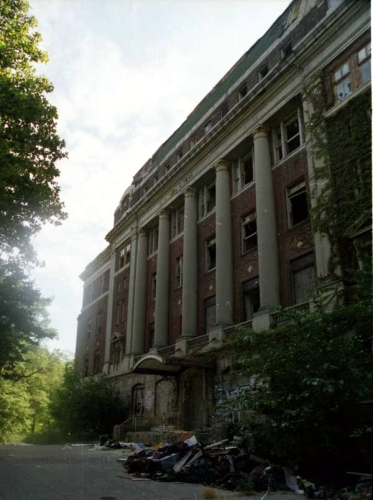Walkabout: The Lords of Pigtown, Part 2
Read Part 1 of this story. Pigtown was a part of Flatbush back in the late 19th century, and the name lasted well into the 1950s, even as the borders of the neighborhood expanded and contracted. Development and progress replaced dire poverty, and ethnic pride overcame prejudice, but Pigtown’s story still has chapters to tell….

Read Part 1 of this story.
Pigtown was a part of Flatbush back in the late 19th century, and the name lasted well into the 1950s, even as the borders of the neighborhood expanded and contracted. Development and progress replaced dire poverty, and ethnic pride overcame prejudice, but Pigtown’s story still has chapters to tell. Please see Part One for Pigtown’s beginnings.
Today we call the general Pigtown neighborhood “Wingate,” a part of East Flatbush tucked between Crown Heights South and Prospect Lefferts Gardens. Originally, Pigtown had been named “Oaklands,” a much nicer name for developers and for neighborhood identity, but the name never took. Unlike most developing areas, this part of Flatbush was not developed in a timely fashion, so blocks of laid-out row houses sat next to wood-framed shanties even in the 1920s. The streets were laid out, but not paved, leaving muddy dirt roads and blocks of scrub filled land filling up with garbage dumped from this and other neighborhoods. In much of Pigtown, poverty sat waiting for progress.
The Irish and then the Italians lived in Pigtown. Both groups led hardscrabble lives as they made their way into American society at the beginning of the 20th century. The rest of Brooklyn knew Pigtown from reports in the local papers, especially the Brooklyn Eagle. The Eagle could be cruel, racist and condescending. The paper was fascinated by the characters of Pigtown, and devoted columns to the exploits of local criminals and toughs. They liked to write down the Irish or Italian accented English used by some residents, quoting them condescendingly, as they spoke of their livestock or how they lived their lives. It was an amusing travelogue, a harmless journey to observe the “other,” which was only a trolley ride away.
Meanwhile, Pigtown was looking after itself. By 1902, it was being called “an Italian colony” by the Eagle, who noted that its unofficial mayor was one Thomas Calandriella. He was said to have been able to “swing every vote in the district.” His photo made the paper on June 24, 1902, when Pigtown celebrated the founding of the St. John’s Mutual Aid Society. This organization was open only to naturalized Italian-American male citizens, and was established to aid neighborhood families with loans, help in navigating the city systems, and other self-help programs. “Tommy” Calandriella was the president.
Sadly, the next day, the paper announced that Mr. Calandriella’s ten-month-old daughter, Rosie, had died on the night of the celebration. The funeral was held at the Church of St. Francis of Assisi, where a celebratory mass had just been held for the St. John’s Society the day before.
Pigtown remained in the Brooklyn Eagle, which reported hijinks there whenever possible, small stuff that wouldn’t have made the paper had they taken place in any other neighborhood. They announced that a teenager had been arrested for throwing his coat over some streetlights during an Italian festival. A break-in at a Pigtown saloon by three men was called “A High Time in Pigtown.” The article recounted the rather routine event, during which time three men were seen fleeing by police, who rounded them up. But the crime, as the paper said, “provides excitement for a famous Flatbush district.”
But this district was not going to remain the Wild West of Flatbush much longer. In 1919, the Carson C. Peck Memorial Hospital opened on a hilly block of Crown Street and Albany Avenue. Carson Peck was one of those American success stories, a man who had achieved much in life, and believed in giving back. He was a New York State man, born in 1858, hailing from Jefferson County. He was a clerk in a dry goods business in Watertown, N.Y., when he met Frank W. Woolworth, and the two men became friends, and eventually business partners. Carson Peck became the Vice President and Treasurer of the Woolworth Company, as Woolworth’s Five and Dime became one of the largest and most successful chains in the United States.
Peck also became president of a newspaper called the Brooklyn Daily Times, and he owned a railroad in Maine. He lived with his wife, Clara, and their son and daughter in Clinton Hill at 381 Clinton Avenue. Mr. Peck, for all his hard work and success, suffered from diabetes, a disease that still has no cure, but had even less treatment in the early 1900s. In 1915, he had to have a finger amputated, which caused his health to further deteriorate, and he died in April of that year.
Clara Peck wanted to honor her husband’s memory, and funded the building of this very large teaching hospital, nursing school and residence in Pigtown, a part of Brooklyn that was in need of not only medical services, but a kick start to finish building up the neighborhood. The hospital was begun in 1918, and finished a year later. The architects were Ludlow & Peabody. Photographs of Pigtown taken in 1923 show the hospital rising high above the rest of the neighborhood, which even then was still dirt roads, shanties, and half-built blocks of rowhouses.
The New York Times hailed the Carson Peck Memorial Hospital as a state of the art facility. From its position on the hill, patients could see the ocean, and the rooms were light and airy, facilitating health, with an abundance of fresh air and sunshine. Even a cubicle shared with other patients could be conducive to healing.
Although it took a lot of time, Carson Peck Hospital, followed by P.S. 91 on East New York and Albany Avenue, spelled the beginning of the end of Pigtown. Some of Pigtown’s more influential members established the Marconi Real Estate Development Company, which began to build homes in the undeveloped lots. Slowly, the streets were paved, utilities came in, and the open pit of Pigtown — which can be seen in the above photograph from 1922 — began to fill in.
Italian Americans continue to live here. The most famous family would be that of one Rudy Guliani, whose family lived in the neighborhood until the 1950s. The neighborhood would be renamed again: “Crown Slope.” That one didn’t stick either. Eventually it became known as Wingate, named after General George Wingate, a Civil War general who went on to champion physical education in schools. The Wingate School (which no longer exists) was named after him, and so too, the neighborhood.
Because the boundaries of Pigtown were wherever someone wanted them, Ebbets Field is often referred to as being built upon the rubble of Pigtown. Charlie Ebbet had bought the field for $500, and it opened in 1913. It’s a nice story, but technically speaking, the ballfield was never in Pigtown. Crow Hill? That’s another story.
Today much of the area is now home to the Hasidic community. The old Carson Peck Hospital was closed in the 1990s, and then just sat there, abandoned. Of course, it was soon ravaged by vandals, and there were fires. It was finally torn down in 2003, and replaced by apartment houses for Hasidic families. Not much remains of Pigtown but the name. Even today, there are message boards where people proudly declare, “I’m from Pigtown.”
The idea for this article came from a Brownstoner reader, Dr. Stephen Tenenbaum, who grew up in Pigtown. He provided anecdotes and the photograph above, which is from the NYC archives. Dr. Tanenbaum also gave me an annotated screen capture of the above photo, which shows the streets. Thank you so much, Doctor!












What's Your Take? Leave a Comment